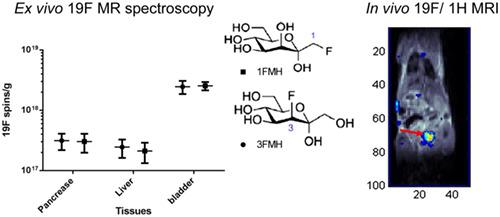当前位置:
X-MOL 学术
›
Contrast Media Mol. Imaging
›
论文详情
Our official English website, www.x-mol.net, welcomes your
feedback! (Note: you will need to create a separate account there.)
In vivo and ex vivo 19‐fluorine magnetic resonance imaging and spectroscopy of beta‐cells and pancreatic islets using GLUT‐2 specific contrast agents
Contrast Media & Molecular Imaging Pub Date : 2016-09-14 , DOI: 10.1002/cmmi.1712 Sayuan Liang 1 , Karim Louchami 1, 2 , Hauke Kolster 1 , Anna Jacobsen 3 , Ying Zhang 2 , Julian Thimm 3 , Abdullah Sener 2 , Joachim Thiem 3 , Willy Malaisse 2 , Tom Dresselaers 1 , Uwe Himmelreich 1
Contrast Media & Molecular Imaging Pub Date : 2016-09-14 , DOI: 10.1002/cmmi.1712 Sayuan Liang 1 , Karim Louchami 1, 2 , Hauke Kolster 1 , Anna Jacobsen 3 , Ying Zhang 2 , Julian Thimm 3 , Abdullah Sener 2 , Joachim Thiem 3 , Willy Malaisse 2 , Tom Dresselaers 1 , Uwe Himmelreich 1
Affiliation

|
The assessment of the β‐cell mass in experimental models of diabetes and ultimately in patients is a hallmark to understand the relationship between reduced β‐cell mass/function and the onset of diabetes. It has been shown before that the GLUT‐2 transporter is highly expressed in both β‐cells and hepatocytes and that D‐mannoheptulose (DMH) has high uptake specificity for the GLUT‐2 transporter. As 19‐fluorine MRI has emerged as a new alternative method for MRI cell tracking because it provides potential non‐invasive localization and quantification of labeled cells, the purpose of this project is to validate β‐cell and pancreatic islet imaging by using fluorinated, GLUT‐2 targeting mannoheptulose derivatives (19FMH) both in vivo and ex vivo. In this study, we confirmed that, similar to DMH, 19FMHs inhibit insulin secretion and increase the blood glucose level in mice temporarily (approximately two hours). We were able to assess the distribution of 19FMHs in vivo with a temporal resolution of about 20 minutes, which showed a quick removal of 19FMH from the circulation (within two hours). Ex vivo MR spectroscopy confirmed a preferential uptake of 19FMH in tissue with high expression of the GLUT‐2 transporter, such as liver, endocrine pancreas and kidney. No indication of further metabolism was found. In summary, 19FMHs are potentially suitable for visualizing and tracking of GLUT‐2 expressed cells. However, current bottlenecks of this technique related to the quick clearance of the compound and relative low sensitivity of 19F MRI need to be overcome. Copyright © 2016 John Wiley & Sons, Ltd.
中文翻译:

使用GLUT-2特异性造影剂的β细胞和胰岛的体内和离体19氟磁共振成像和光谱学
对糖尿病实验模型以及最终在患者中对β细胞质量的评估是了解β细胞质量/功能降低与糖尿病发作之间关系的标志。之前已经证明GLUT-2转运蛋白在β细胞和肝细胞中都高度表达,而D-甘露庚糖(DMH)对GLUT-2转运蛋白具有高摄取特异性。由于19氟MRI已经成为一种新的MRI细胞追踪替代方法,因为它提供了潜在的非侵入性定位和定量标记细胞的功能,因此该项目的目的是通过使用氟化的GLUT来验证β细胞和胰岛成像‐2在体内和体外均靶向甘露庚糖衍生物(19 FMH)。在这项研究中,我们证实,类似于DMH,19种FMH会暂时(大约两个小时)抑制胰岛素分泌并增加小鼠的血糖水平。我们能够以大约20分钟的时间分辨率评估体内19种FMH的分布,这显示了从循环中(两个小时内)快速去除了19种FMH。离体MR光谱证实在肝,内分泌胰腺和肾脏等GLUT-2转运蛋白高表达的组织中优先摄取19 FMH。没有发现进一步代谢的迹象。综上所述,19FMHs可能适合可视化和跟踪GLUT-2表达的细胞。但是,该技术的当前瓶颈与化合物的快速清除和19 F MRI相对较低的灵敏度有关。版权所有©2016 John Wiley&Sons,Ltd.
更新日期:2016-09-14
中文翻译:

使用GLUT-2特异性造影剂的β细胞和胰岛的体内和离体19氟磁共振成像和光谱学
对糖尿病实验模型以及最终在患者中对β细胞质量的评估是了解β细胞质量/功能降低与糖尿病发作之间关系的标志。之前已经证明GLUT-2转运蛋白在β细胞和肝细胞中都高度表达,而D-甘露庚糖(DMH)对GLUT-2转运蛋白具有高摄取特异性。由于19氟MRI已经成为一种新的MRI细胞追踪替代方法,因为它提供了潜在的非侵入性定位和定量标记细胞的功能,因此该项目的目的是通过使用氟化的GLUT来验证β细胞和胰岛成像‐2在体内和体外均靶向甘露庚糖衍生物(19 FMH)。在这项研究中,我们证实,类似于DMH,19种FMH会暂时(大约两个小时)抑制胰岛素分泌并增加小鼠的血糖水平。我们能够以大约20分钟的时间分辨率评估体内19种FMH的分布,这显示了从循环中(两个小时内)快速去除了19种FMH。离体MR光谱证实在肝,内分泌胰腺和肾脏等GLUT-2转运蛋白高表达的组织中优先摄取19 FMH。没有发现进一步代谢的迹象。综上所述,19FMHs可能适合可视化和跟踪GLUT-2表达的细胞。但是,该技术的当前瓶颈与化合物的快速清除和19 F MRI相对较低的灵敏度有关。版权所有©2016 John Wiley&Sons,Ltd.











































 京公网安备 11010802027423号
京公网安备 11010802027423号